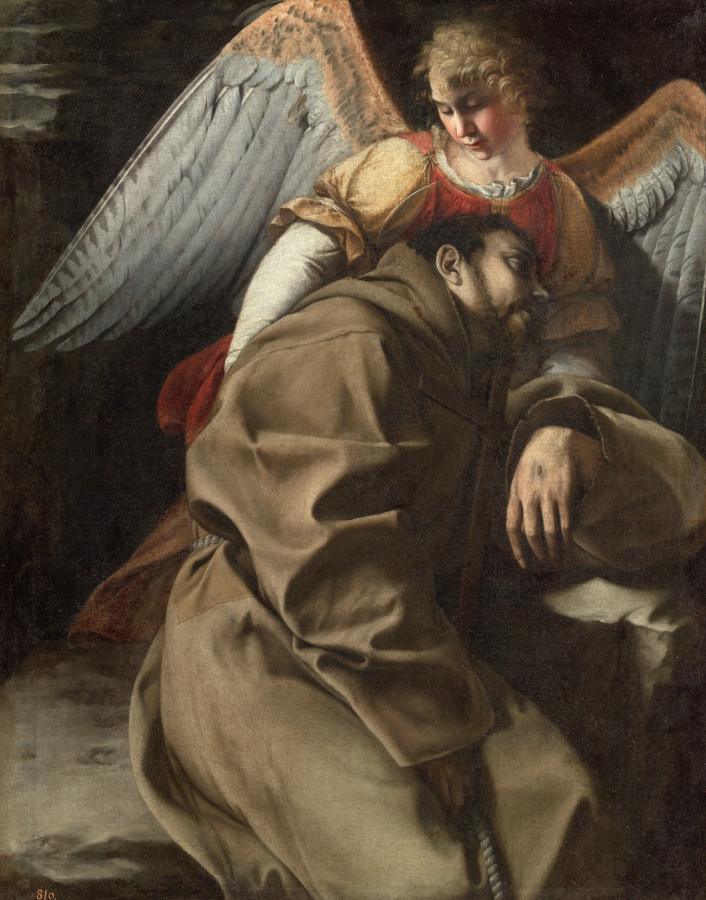Gentileschi, Orazio (1563-1639)
San Francesco sorretto dall’angelo (Saint Francis supported by an Angel)
c.1607
Oil on canvas, 126 x 98 cm
Museo del Prado, Madrid
The subject of the angelic consolation of Saint Francis became popular in the second half of the sixteenth century as a result of the Catholic Church’s renewed appreciation of his mystical experiences, almost to the exclusion of the more picturesque episodes of the saint’s life that had characterised traditional iconography; for example, his encounter with the wolf of Gubbio, and the invention of the crib at Greccio. His visions, in particular the episode when he became marked with the wounds of Jesus’s crucifixion, were understood as both the sign and reward of his perfect conformity to Christ. The parallel between the iconography of the Prado painting and the angelic consolation afforded to Christ in the Garden of Gethsemane shortly before his crucifixion is evident. Here Francis has collapsed on a rock and is supported by a blonde, youthful angel who looks lovingly down upon him, open wings spread across the picture plane. A simple wooden cross rests on the saint’s lap and his left hand, marked with the stigmata, is held up for the viewer’s contemplation, as one frequently finds in paintings of the dead Christ. In this nocturne moonlight casts a silvery sheen on Saint Francis’s pale face and on the broad folds of his Franciscan habit, investing the scene with an ethereal quality. When Gentileschi was in London in the service of King Charles I, from 1626 until his death in 1639, he painted the great Finding of Moses, 1633, for Philip IV of Spain. The work was delivered to Madrid by his son Francesco in 1633 and now hangs in the Prado. It is not known for whom Saint Francis supported by an angel was made, nor exactly when it arrived in Spain. Previously the work was thought to have belonged to the painter Carlo Maratti, whose collection was acquired for the Spanish crown in 1723, but this is now known to be incorrect. Gentileschi painted this subject several times. Two paintings showing the saint and the angel full-length date from about 1600 (one is in the Museum of Fine Arts, Boston, and the other in a private collection), and both have an angular Mannerist quality. There is another version, painted in c.1612, and much closer to the Prado picture in style and composition, in Palazzo Barberini, Rome. The stigmatisation of Saint Francis is also the subject of an altarpiece Gentileschi made for the chapel of the Savelli di Palombara family in the church of San Silvestro in Capite, Rome, and there is a reduced autographed replica of this work on canvas, both of which date from the second half of the 1610s. A Saint Francis by Gentileschi, now lost (but possibly identifiable in the collection of the recently deceased Polish collector Barbara Piasecka Johnson), was recorded at Wimbledon Palace, outside London, in 1649 and may have been commissioned by Queen Henrietta Maria, wife of King Charles I, who was a patron of the artist when he was in England and who had a great devotion to Saint Francis of Assisi. The painter Orazio Lomi, best known by his maternal surname, Gentileschi, was born in Pisa, the son of a Florentine goldsmith. He moved to Rome in 1576 or 1578 and found employment in the large workshops executing decorative cycles in the city’s basilicas. His identifiable works from the 1590s, mostly frescoes, are conventional late Mannerist works. Gentileschi‘s style changed radically after 1600 as a result of his contact with Caravaggio, with whom he appears to have been on friendly terms. Gentileschi‘s highly refined and lyrical Caravaggism can be seen in Saint Francis supported by an angel, c.1605–07. He is known to have shared some artistic props with Caravaggio, including a capuchin habit and some theatrical angel´s wings, and it is possible these were the ones used for this work (Finaldi, G.: Italian Masterpieces. From Spain’s Royal Court, Museo del Prado, 2014, p. 124). (MNP)
